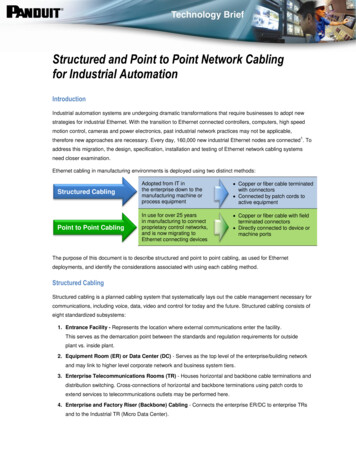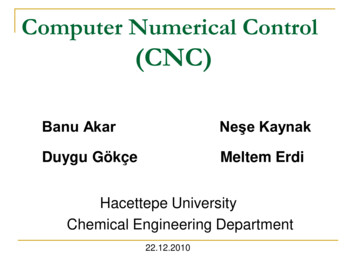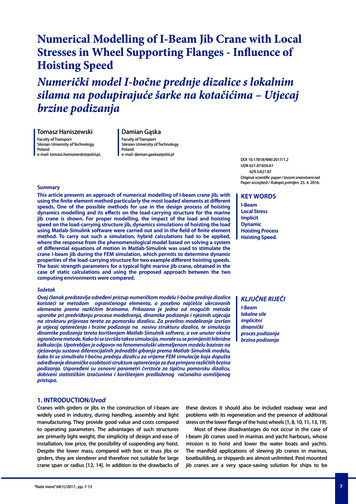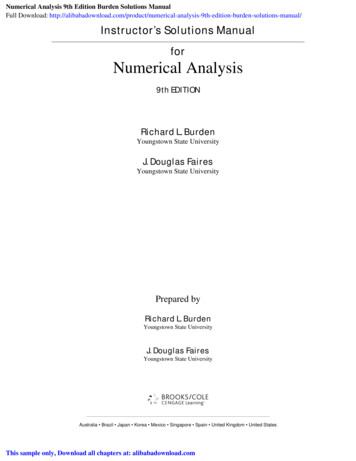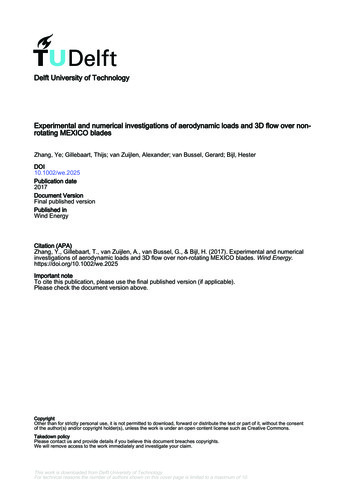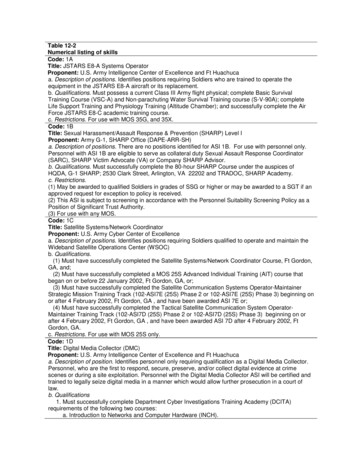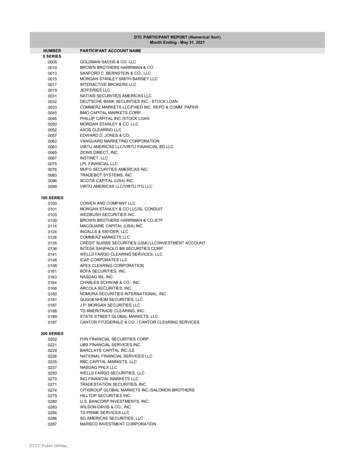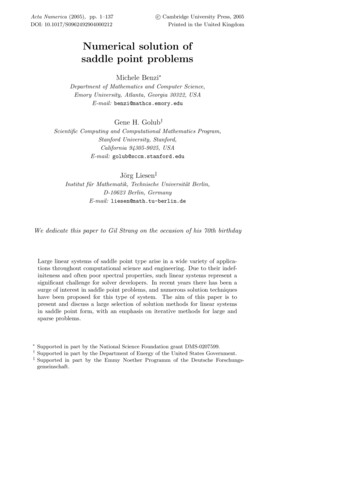
Transcription
Acta Numerica (2005), pp. 1–137DOI: 10.1017/S0962492904000212c Cambridge University Press, 2005 Printed in the United KingdomNumerical solution ofsaddle point problemsMichele Benzi Department of Mathematics and Computer Science,Emory University, Atlanta, Georgia 30322, USAE-mail: benzi@mathcs.emory.eduGene H. Golub†Scientific Computing and Computational Mathematics Program,Stanford University, Stanford,California 94305-9025, USAE-mail: golub@sccm.stanford.eduJörg Liesen‡Institut für Mathematik, Technische Universität Berlin,D-10623 Berlin, GermanyE-mail: liesen@math.tu-berlin.deWe dedicate this paper to Gil Strang on the occasion of his 70th birthdayLarge linear systems of saddle point type arise in a wide variety of applications throughout computational science and engineering. Due to their indefiniteness and often poor spectral properties, such linear systems represent asignificant challenge for solver developers. In recent years there has been asurge of interest in saddle point problems, and numerous solution techniqueshave been proposed for this type of system. The aim of this paper is topresent and discuss a large selection of solution methods for linear systemsin saddle point form, with an emphasis on iterative methods for large andsparse problems. †‡Supported in part by the National Science Foundation grant DMS-0207599.Supported in part by the Department of Energy of the United States Government.Supported in part by the Emmy Noether Programm of the Deutsche Forschungsgemeinschaft.
2M. Benzi, G. H. Golub and J. LiesenCONTENTS1 Introduction2 Applications leading to saddle point problems3 Properties of saddle point matrices4 Overview of solution algorithms5 Schur complement reduction6 Null space methods7 Coupled direct solvers8 Stationary iterations9 Krylov subspace methods10 Preconditioners11 Multilevel methods12 Available software13 Concluding remarksReferences251429303240434959961051071091. IntroductionIn recent years, a large amount of work has been devoted to the problemof solving large linear systems in saddle point form. The reason for thisinterest is the fact that such problems arise in a wide variety of technicaland scientific applications. For example, the ever-increasing popularity ofmixed finite element methods in engineering fields such as fluid and solidmechanics has been a major source of saddle point systems (Brezzi andFortin 1991, Elman, Silvester and Wathen 2005c). Another reason for thissurge in interest is the extraordinary success of interior point algorithmsin both linear and nonlinear optimization, which require at their heart thesolution of a sequence of systems in saddle point form (Nocedal and Wright1999, Wright 1992, Wright 1997).Because of the ubiquitous nature of saddle point systems, methods andresults on their numerical solution have appeared in a wide variety of books,journals and conference proceedings, justifying a comprehensive survey ofthe subject. The purpose of this article is to review many of the most promising solution methods, with an emphasis on iterative methods for large andsparse problems. Although many of these solvers have been developed withspecific applications in mind (for example, Stokes-type problems in fluiddynamics), it is possible to discuss them in a fairly general setting usingstandard numerical linear algebra concepts, the most prominent being perhaps the Schur complement. Nevertheless, when choosing a preconditioner(or developing a new one), knowledge of the origin of the particular problem
3Numerical solution of saddle point problemsat hand is essential. Although no single ‘best’ method exists, very effectivesolvers have been developed for some important classes of problems. Wetherefore devote some space to a discussion of saddle point problems arisingin a few selected applications.It is hoped that the present survey will prove useful to practitioners whoare looking for guidance in the choice of a solution method for their ownapplication, to researchers in numerical linear algebra and scientific computing, and especially to graduate students as an introduction to this veryrich and important subject.Notation. We have used boldface to denote vectors in sections describingfluid dynamics applications, where this is traditional, but we have otherwisefollowed the standard practice of numerical linear algebra and employed nospecial notation.1.1. Problem statement and classificationThe subject of this paper is the solution of block 2 2 linear systems of theform xfA B1T , or Au b,(1.1)gB2 C yA Rn n ,B1 , B2 Rm n ,C Rm mwith n m.(1.2)It is obvious that, under suitable partitioning, any linear system can be castin the form (1.1)–(1.2). We explicitly exclude the case where A or one orboth of B1 , B2 are zero. When the linear system describes a (generalized)saddle point problem, the constituent blocks A, B1 , B2 and C satisfy oneor more of the following conditions:C1C2C3C4C5A is symmetric: A ATthe symmetric part of A, H 12 (A AT ), is positive semidefiniteB1 B2 BC is symmetric (C C T ) and positive semidefiniteC O (the zero matrix)Note that C5 implies C4. The most basic case is obtained when allthe above conditions are satisfied. In this case A is symmetric positivesemidefinite and we have a symmetric linear system of the form xfA BT .(1.3)ygB OThis system arises as the first-order optimality conditions for the followingequality-constrained quadratic programming problem:1(1.4)min J(x) xT Ax f T x2subject to Bx g.(1.5)
4M. Benzi, G. H. Golub and J. LiesenIn this case the variable y represents the vector of Lagrange multipliers.Any solution (x , y ) of (1.3) is a saddle point for the Lagrangian1L(x, y) xT Ax f T x (Bx g)T y,2hence the name ‘saddle point problem’ given to (1.3). Recall that a saddlepoint is a point (x , y ) Rn m that satisfiesL(x , y) L(x , y ) L(x, y ) for any x Rn and y Rm ,or, equivalently,min max L(x, y) L(x , y ) max min L(x, y).xyyxSystems of the form (1.3) also arise in nonlinearly constrained optimization (sequential quadratic programming and interior point methods), influid dynamics (Stokes’ problem), incompressible elasticity, circuit analysis,structural analysis, and so forth; see the next section for a discussion ofapplications leading to saddle point problems.Another important special case is when conditions C1–C4 are satisfied,but not C5. In this case we have a block linear system of the form xfA BT .(1.6)gB C yProblems of this kind frequently arise in the context of stabilized mixed finite element methods. Stabilization is used whenever the discrete variables xand y belong to finite element spaces that do not satisfy the Ladyzhenskaya–Babuška–Brezzi (LBB, or inf-sup) condition (Brezzi and Fortin 1991). Another situation leading to a nonzero C is the discretization of the equationsdescribing slightly compressible fluids or solids (Braess 2001, Chapter 6.3).Systems of the form (1.6) also arise from regularized, weighted least-squaresproblems (Benzi and Ng 2004) and from certain interior point methods inoptimization (Wright 1992, Wright 1997). Often the matrix C has smallnorm compared to the other blocks.In the literature, the phrase generalized saddle point problem has beenused primarily to allow for the possibility of a nonsymmetric matrix A in(1.1). In such problems either A AT (with condition C2 usually satisfied),or B1 B2 , or both. The most important example is perhaps that of thelinearized Navier–Stokes equations, where linearization has been obtainedby Picard iteration or by some variant of Newton’s method. See Ciarlet Jr.,Huang and Zou (2003), Nicolaides (1982) and Szyld (1981) for additionalexamples. We note that our definition of generalized saddle point problemas a linear system of the form (1.1)–(1.2), where the blocks A, B1 , B2 andC satisfy one or more of the conditions C1–C5, is the most general possible,and it contains previous definitions as special cases.
Numerical solution of saddle point problems5In the vast majority of cases, linear systems of saddle point type havereal coefficients, and in this paper we restrict ourselves to the real case.Complex coefficient matrices, however, do arise in some cases; see, e.g.,Bobrovnikova and Vavasis (2000), Mahawar and Sarin (2003) and Strang(1986, page 117). Most of the results and algorithms reviewed in this paperadmit straightforward extensions to the complex case.1.2. Sparsity, structure and sizeAlthough saddle point systems come in all sizes and with widely differentstructural and sparsity properties, in this paper we are mainly interestedin problems that are both large and sparse. This justifies our emphasison iterative solvers. Direct solvers, however, are still the preferred methodin optimization and other areas. Furthermore, direct methods are oftenused in the solution of subproblems, for example as part of a preconditionersolve. Some of the algorithms considered in this paper are also applicableif one or more of the blocks in A happen to be dense, as long as matrixvector products with A can be performed efficiently, typically in O(n m)time. This means that if a dense block is present, it must have a specialstructure (e.g., Toeplitz, as in Benzi and Ng (2004) and Jin (1996)) or itmust be possible to approximate its action on a vector with (nearly) linearcomplexity, as in the fast multipole method (Mahawar and Sarin 2003).Frequently, the matrices that arise in practice have quite a bit of structure. For instance, the A block is often block diagonal, with each diagonalblock endowed with additional structure. Many of the algorithms discussedin this paper are able to exploit the structure of the problem to gain efficiency and save on storage. Sometimes the structure of the problem suggestssolution algorithms that have a high degree of parallelism. This last aspect,however, is not emphasized in this paper. Finally we mention that in mostapplications n is larger than m, often much larger.2. Applications leading to saddle point problemsAs already mentioned, large-scale saddle point problems occur in manyareas of computational science and engineering. The following is a list ofsome fields where saddle point problems naturally arise, together with somereferences: computational fluid dynamics (Glowinski 1984, Quarteroni and Valli1994, Temam 1984, Turek 1999, Wesseling 2001) constrained and weighted least squares estimation (Björck 1996, Goluband Van Loan 1996) constrained optimization (Gill, Murray and Wright 1981, Wright 1992,Wright 1997)
6M. Benzi, G. H. Golub and J. Liesen economics (Arrow, Hurwicz and Uzawa 1958, Duchin and Szyld 1979,Leontief, Duchin and Szyld 1985, Szyld 1981) electrical circuits and networks (Bergen 1986, Chua, Desoer and Kuh1987, Strang 1986, Tropper 1962) electromagnetism (Bossavit 1998, Perugia 1997, Perugia, Simonciniand Arioli 1999) finance (Markowitz 1959, Markowitz and Perold 1981) image reconstruction (Hall 1979) image registration (Haber and Modersitzki 2004, Modersitzki 2003) interpolation of scattered data (Lyche, Nilssen and Winther 2002, Sibson and Stone 1991) linear elasticity (Braess 2001, Ciarlet 1988) mesh generation for computer graphics (Liesen, de Sturler, Sheffer,Aydin and Siefert 2001) mixed finite element approximations of elliptic PDEs (Brezzi 1974,Brezzi and Fortin 1991, Quarteroni and Valli 1994) model order reduction for dynamical systems (Freund 2003, Heres andSchilders 2005, Stykel 2005) optimal control (Battermann and Heinkenschloss 1998, Battermannand Sachs 2001, Betts 2001, Biros and Ghattas 2000, Nguyen 2004) parameter identification problems (Burger and Mühlhuber 2002, Haberand Ascher 2001, Haber, Ascher and Oldenburg 2000).Quite often, saddle point systems arise when a certain quantity (such asthe energy of a physical system) has to be minimized, subject to a set oflinear constraints. In this case the Lagrange multiplier y usually has aphysical interpretation and its computation is also of interest. For example,in incompressible flow problems x is a vector of velocities and y a vector ofpressures. In the complementary energy formulation of structural mechanicsx is the vector of internal forces, y represents the nodal displacements of thestructure. For resistive electrical networks y represents the nodal potentials,x being the vector of currents.In some cases, such as fluid dynamics or linear elasticity, saddle pointproblems result from the discretization of systems of partial differentialequations with constraints. Typically the constraints represent some basic conservation law, such as mass conservation in fluid dynamics. In othercases, such as resistive electrical networks or structural analysis, the equations are discrete to begin with. Now the constraints may correspond to thetopology (connectivity) of the system being studied. Because saddle pointequations can be derived as equilibrium conditions for a physical system,they are sometimes called equilibrium equations. See Strang (1986, 1988) fora very nice discussion of equilibrium equations throughout applied mathematics. Another popular name for saddle point systems, especially in the
Numerical solution of saddle point problems7optimization literature, is ‘KKT system’, from the Karush–Kuhn–Tuckerfirst-order optimality conditions; see Nocedal and Wright (1999, page 328)for precise definitions, and Golub and Greif (2003) and Kjeldsen (2000) forhistorical notes.Systems of the form (1.1)–(1.2) also arise from non-overlapping domaindecomposition when interface unknowns are numbered last, as well as fromFETI-type schemes when Lagrange multipliers are used to ensure continuityat the interfaces; see for instance Chan and Mathew (1994), Farhat andRoux (1991), Hu, Shi and Yu (2004), Quarteroni and Valli (1999) and Toselliand Widlund (2004).It is of course not possible for us to cover here all these different applications. We choose instead to give some details about three classes ofproblems lea
in saddle point form, with an emphasis on iterative methods for large and sparse problems. Supported in part by the National Science Foundation grant DMS-0207599. † Supported in part by the Department of Energy of the United States Government. ‡ Supported in part by the Emmy Noether Programm of the Deutsche Forschungs-gemeinschaft. 2 M. Benzi, G. H. Golub and J. Liesen CONTENTS 1 .

